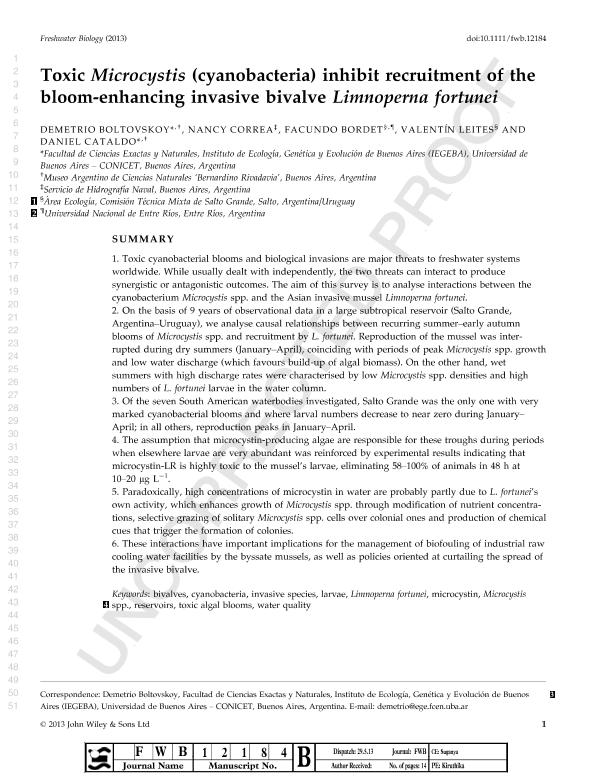Artículo
Toxic Microcystis (cyanobacteria) inhibit recruitment of the bloom-enhancing invasive bivalve Limnoperna fortunei
Boltovskoy, Demetrio ; Correa, Nancy Myriam; Bordet, Hugo Facundo; Leites, Valentín; Cataldo, Daniel Hugo
; Correa, Nancy Myriam; Bordet, Hugo Facundo; Leites, Valentín; Cataldo, Daniel Hugo
 ; Correa, Nancy Myriam; Bordet, Hugo Facundo; Leites, Valentín; Cataldo, Daniel Hugo
; Correa, Nancy Myriam; Bordet, Hugo Facundo; Leites, Valentín; Cataldo, Daniel Hugo
Fecha de publicación:
09/2013
Editorial:
Wiley Blackwell Publishing, Inc
Revista:
Freshwater Biology (print)
ISSN:
0046-5070
Idioma:
Inglés
Tipo de recurso:
Artículo publicado
Clasificación temática:
Resumen
Toxic cyanobacterial blooms and biological invasions are major threats to freshwater systems worldwide. While usually dealt with independently, the two threats can interact to produce synergistic or antagonistic outcomes. The aim of this survey is to analyse interactions between the cyanobacterium Microcystis spp. and the Asian invasive mussel Limnoperna fortunei. On the basis of 9 years of observational data in a large subtropical reservoir (Salto Grande, Argentina-Uruguay), we analyse causal relationships between recurring summer-early autumn blooms of Microcystis spp. and recruitment by L. fortunei. Reproduction of the mussel was interrupted during dry summers (January-April), coinciding with periods of peak Microcystis spp. growth and low water discharge (which favours build-up of algal biomass). On the other hand, wet summers with high discharge rates were characterised by low Microcystis spp. densities and high numbers of L. fortunei larvae in the water column. Of the seven South American waterbodies investigated, Salto Grande was the only one with very marked cyanobacterial blooms and where larval numbers decrease to near zero during January-April; in all others, reproduction peaks in January-April. The assumption that microcystin-producing algae are responsible for these troughs during periods when elsewhere larvae are very abundant was reinforced by experimental results indicating that microcystin-LR is highly toxic to the mussel's larvae, eliminating 58-100% of animals in 48 h at 10-20 μg L-1. Paradoxically, high concentrations of microcystin in water are probably partly due to L. fortunei's own activity, which enhances growth of Microcystis spp. through modification of nutrient concentrations, selective grazing of solitary Microcystis spp. cells over colonial ones and production of chemical cues that trigger the formation of colonies. These interactions have important implications for the management of biofouling of industrial raw cooling water facilities by the byssate mussels, as well as policies oriented at curtailing the spread of the invasive bivalve.
Archivos asociados
Licencia
Identificadores
Colecciones
Articulos(IEGEBA)
Articulos de INSTITUTO DE ECOLOGIA, GENETICA Y EVOLUCION DE BS. AS
Articulos de INSTITUTO DE ECOLOGIA, GENETICA Y EVOLUCION DE BS. AS
Citación
Boltovskoy, Demetrio; Correa, Nancy Myriam; Bordet, Hugo Facundo; Leites, Valentín; Cataldo, Daniel Hugo; Toxic Microcystis (cyanobacteria) inhibit recruitment of the bloom-enhancing invasive bivalve Limnoperna fortunei; Wiley Blackwell Publishing, Inc; Freshwater Biology (print); 58; 9; 9-2013; 1968-1981
Compartir
Altmétricas



